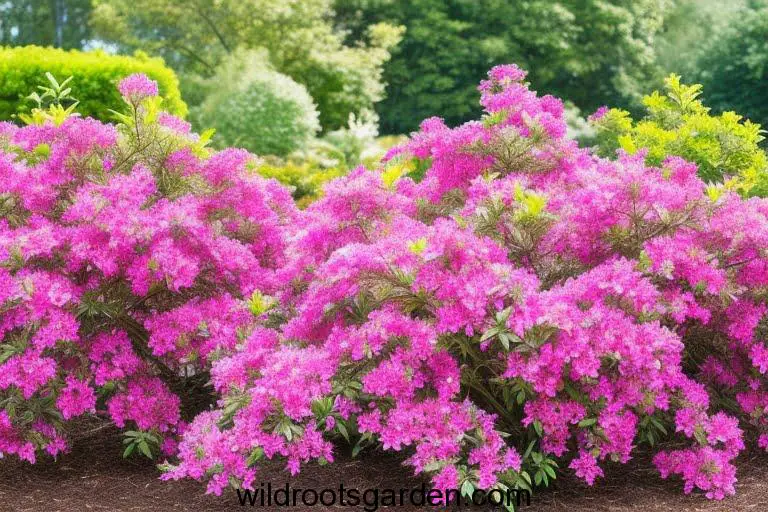Few plants can match the elegance of azaleas in terms of adding beauty and color to your yard. The brilliant blossoms of these magnificent blooming shrubs make them a favorite among garden aficionados. If you’re thinking about incorporating azaleas into your outdoor area, you might be wondering if you can grow them there. This article will go over the procedure for planting azaleas outside and provide you with the advice you need to make sure they flourish and stay healthy.
Table of Contents
Understanding Azaleas
The Rhododendron genus includes azaleas as a form of blooming plant. They originate from many places, including North America, Europe, and Asia. Azaleas are well known for their dazzling, trumpet-shaped flowers, which are available in a variety of hues, including pink, white, red, and purple. These plants normally bloom in the spring, filling your yard with exquisite color.

Suitable Climate for Planting Azaleas
It’s crucial to take your area’s environment into account before growing azaleas outdoors. Azaleas flourish in warm areas that feature mild winters and pleasant, humid summers. Their fragile leaves can be scorched by direct sunlight; therefore, they prefer locations with some shade. But, some azalea cultivars are more tolerant of full sun, so it’s crucial to pick the appropriate kind for your particular area.
Choosing the Right Location for Azaleas
The proper place must be chosen for azaleas to develop well. Choose a spot in your garden that has dappled sunlight or partial shade. They may compete with other plants for nutrients and water if you plant them close to trees or shrubs with robust root systems. Make sure the location is well-draining to avoid waterlogging, which can be harmful to the health of azaleas.
Soil Preparation for Azaleas
Acidic soil with a pH range of 4.5 to 6.0 is ideal for azalea growth. It’s crucial to amend the soil to suit these needs before planting. With a soil testing kit that is readily accessible at most garden centers, start by determining the pH of your soil. By adding sulfur or other acidifying substances, you can reduce the pH if it is higher than the advised range. Moreover, adding organic matter, such as peat moss or compost, helps increase the fertility and drainage of the soil.
Planting Azaleas in the Ground
It’s time to plant your azaleas now that you have selected the ideal site and prepped the soil. In order to plant successfully, follow these steps:
- Dig a hole that is wider and slightly shallower than the root ball of the azalea plant.
- Gently remove the plant from its container, loosening any circling roots.
- Place the plant in the hole, making sure it sits at the same depth as it did in the container.
- Backfill the hole with soil, firming it gently around the roots.
- Water the newly planted azalea thoroughly to settle the soil.

Watering and Fertilizing Azaleas
Azaleas are vulnerable to drying out because of their shallow root systems. To keep them hydrated, especially during dry spells, regular watering is necessary. Instead of frequent superficial waterings, provide deep, thorough ones. A layer of organic mulch applied around the base of the plants can aid in moisture retention and control soil temperature.
Azalea fertilization is essential for their growth and general well-being. Employ a balanced, slow-release fertilizer designed especially for plants that thrive in acid. Use it as directed on the packaging, typically in the early spring and late summer. Avoid using too much fertilizer because it might cause nutrient imbalances and harm the plants.
Pruning and Maintenance of Azaleas
Azaleas may be pruned effectively to retain their size and shape while also promoting new growth and profuse flowering. Azaleas should be pruned as soon as the flowering season is over to avoid removing the flower buds for the following year. To increase air circulation, remove any dead or diseased branches and thin out dense vegetation.
Regular inspections for pests and diseases are essential for maintenance. Aphids, lace bugs, and spider mites are typical pests that can harm azaleas. Use immediate organic or chemical control measures for any infestations. Moreover, watch out for indications of ailments like powdery mildew or root rot. These problems can be avoided with the help of correct plant spacing, good air circulation, and proper watering.

Protecting Azaleas from Pests and Diseases
Maintaining proper garden hygiene is crucial for keeping pests and illnesses away from your azaleas. Regularly remove trash and fallen leaves since they can hold insects and fungus spores. Regularly check your plants for any signs of harm or discomfort, and act appropriately at the first indication of a problem. You can stop serious infections or infestations from spreading by taking preventative measures.
Common Issues and Troubleshooting
Despite your best efforts, you may encounter some challenges while growing azaleas. Here are a few common issues and troubleshooting tips:
Yellowing leaves: This can indicate nutrient deficiencies or improper watering. Adjust fertilization and watering practices accordingly.
Lack of blooms: Insufficient light, improper pruning, or extreme temperatures can hinder blooming. Ensure your azaleas receive adequate light, prune them correctly, and protect them from extreme heat or cold.
Leaf discoloration or spots: This could be a sign of fungal diseases. Remove the affected leaves and treat them with appropriate fungicides if necessary.
Stunted growth: Poor soil conditions, root damage, or improper planting can lead to stunted growth. Ensure you have prepared the soil adequately and followed proper planting techniques.
Propagating Azaleas
You can propagate azaleas using a variety of techniques, including stem cuttings, layering, or grafting if you want to increase your collection or give these lovely plants to others. It’s important to do your research and pick the method that best fits your resources and abilities because each has its own requirements and techniques.

Benefits of Planting Azaleas
Planting azaleas can bring numerous benefits to your garden and outdoor space. Some advantages include:
- Adding vibrant color and beauty to your landscape, particularly during the spring season.
- Attracting pollinators like bees and butterflies promotes a healthy ecosystem.
- Enhancing curb appeal and increasing the value of your property.
- Creating privacy screens or focal points in your garden design.
- Enjoying the therapeutic benefits of gardening and connecting with nature.
Design Ideas for Incorporating Azaleas in Landscapes
To maximize the visual impact of your azaleas, consider the following design ideas:
- Create a colorful azalea border along walkways or fences.
- Plant azaleas under taller trees or near ponds for a naturalistic woodland garden.
- Combine different azalea varieties with complementary flowers or foliage plants for a layered effect.
- Use azaleas as anchor plants in mixed shrub borders.
- Plant azaleas in containers for a versatile and portable display.
Conclusion
In conclusion, growing azaleas outdoors may be gratifying work that will add a splash of elegant color to your yard. You may successfully grow and enjoy these lovely flowering shrubs by taking into account elements like climate, location, soil preparation, watering, and care. Do not forget to maintain sufficient care, keep an eye out for pests and diseases, and take preventative measures to deal with any potential concerns. With due consideration and tenderness
FAQS
Can I plant an azalea outside?
Yes, you can plant an azalea outside, as it is a popular shrub that thrives in outdoor environments.
What are the ideal conditions for planting an azalea outside?
Azaleas prefer partial shade or filtered sunlight, well-drained acidic soil with a pH between 4.5 and 6.0, and a location sheltered from strong winds.
When is the best time to plant an azalea outside?
The best time to plant azaleas outside is in the early spring or fall when the temperatures are mild. This allows the plant to establish its roots before extreme weather conditions occur.
How should I prepare the soil before planting an azalea outside?
Before planting an azalea outside, it is important to prepare the soil by amending it with organic matter like compost or peat moss. This helps improve drainage and provides essential nutrients for the plant’s growth.
How often should I water an azalea planted outside?
Azaleas planted outside should be watered regularly, especially during dry periods. It is recommended to water them deeply once or twice a week, ensuring that the soil remains moist but not waterlogged.

